 |
 |
 |
| |
MK-7009 Significantly Improves Rapid Viral Response (RVR) in Combination with Pegylated Interferon Alfa-2a and Ribavirinin Patients with Chronic Hepatitis C (CHC) Genotype 1 Infection
|
| |
| |
EASL April 23-26 2009 Copenhagen Denmark
Reported by Jules Levin
Michael P. Manns,1 Edward Gane,2 Maribel Rodriguez-Torres,3 Albrecht Stoehr,4 Chau-Ting Yeh,5 Richard T. Wiedmann,6 Peggy M. Hwang,7 Erin Quirk,6 Jeffrey Silber,6 and Andrew W. Lee6
1Medical School of Hannover, Hannover, Germany, 2Auckland Clinical Studies, Auckland, New Zealand, 3Fundacion de Investigacion de Diego, San Juan, and Ponce School of Medicine, Ponce, Puerto Rico, 4ifi-institute for interdisciplinary medicine, Hamburg, Germany,5Liver Research Unit, Chang Gung Medical Center, Taipei, Taiwan, 6ID/Vaccines Clinical Research, Merck Research Laboratories, West Point, PA, USA, 7Biostatistics, Merck Research Laboratories, West Point, PA, USA *for the MK-7009 Protocol 007 Study
Copyright 2009 Merck & Co., Inc. Whitehouse Station, NJ, USA All rights reserverd
AUTHOR SUMMARY
MK-7009 showed potent antiviral effect at all doses tested.
- Viral suppression maintained after MK-7009 dosing ended, through Day 42
- Similarly high rates of RVR in all MK-7009 treatment groups:
Dose-differentiation limited by small sample size·
MK-7009 was generally well-tolerated with no serious adverse events and no adverse events leading to discontinuation.
- Incidence of vomiting appears higher in 600 mg bid dose group: Most events were short duration, of mild intensity, and no anti-emetics were required·
These results support further development of MK-7009 as an anti-HCV treatment.
INTRODUCTION
The low rate of virologic cure [40-50% sustained virologic response (SVR) of genotype 1 HCV], long treatment duration (48 weeks), and significant side effects of pegylated interferon and ribavirin therapy highlight the pressing medical need for advancement in anti-HCV therapy.
MK-7009 is a non-covalent competitive inhibitor of HCV NS3/4A protease, with demonstrated safety and efficacy when administered as monotherapy for 8 days.
We now present the primary analysis from an ongoing Phase IIa study of MK-7009 for 28 · days in combination with pegylated-interferon and ribavirin (peg-IFN/RBV).
METHODS
Study Design
A randomized, placebo-controlled, double-blind study of MK-7009 in treatment-naive patients with chronic genotype 1 HCV infection.
MK-7009 was administered for 28 days with peg-IFN/RBV in 1 of 5 regimens: placebo, 300 mg bid, 600 bid, 600 mg qd, or 800 mg qd.
All patients continued peg-IFN/RBV for an additional 44 weeks.
The primary endpoint was the percent of subjects with viral suppression to below the lower limit of detection at day 28 (rapid viral response or RVR).
HCV RNA was measured by Roche Cobas Taqman which has a lower limit of detection (LLOD) of 10 IU/mL and a lower limit of quantification (LLOQ) of 25 IU/mL.
Primary hypotheses
RVR rates for at least 1 MK-7009-treated group superior to placebo.
Acceptable safety and tolerability of MK-7009 compared with placebo.
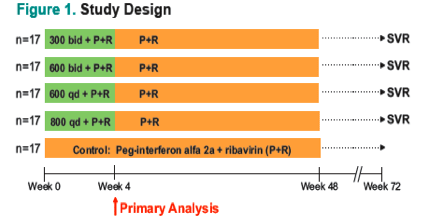
Patient Population
Key Inclusion Criteria:
- Chronic, compensated genotype 1 HCV infection
- HCV RNA ≥400,000 IU/mL at screening
- Treatment-naive
Key Exclusion Criteria:
- Non-HCV-related chronic hepatitis
- HIV co-infection
- Evidence of cirrhosis on liver biopsy or approved non-invasive imaging
- Any other condition contraindicated for treatment with peg-IFN/RBV
Data Analysis
Safety analysis based on the All-patients-as-treated population
Reasons for exclusion from Per-protocol (PP) population:
- Taking a restricted concomitant medicine
- Missing more than the allowed number of doses for MK-7009/ placebo, peg-IFN, or RBV
Statistical Definition of Superiority for RVR rates:
(Lower bound of 95% CI of [MK-7009 group RVR - placebo group --RVR]) >0
Protocol-defined Virologic Failure:
- Relapse: a >1 log increase from nadir at two consecutive --measurements, or HCV RNA >100 IU/mL on 2 measurements after LLOD
- Nonresponder: ≤2 log decrease through Day 28--
Because the study is ongoing, some data points are subject to change by the time the final study report is submitted
Viral Resistance: Population Sequencing of NS3/4A gene
- DNA Amplicons obtained at baseline and the indicated failure time points were purified and subjected to DNA-sequence analysis.
- For technical reasons, population sequence analysis could only be performed on patient samples with >1000 IU/mL HCV RNA.
Results
Patient Population
95 patients with no prior treatment for HCV infection were randomized to 1 of 5 groups [placebo and 4 dose groups of MK-7009 (Table 1)].
One patient withdrew consent after screening and did not receive any study therapy after randomization. This patient was excluded from all analyses.
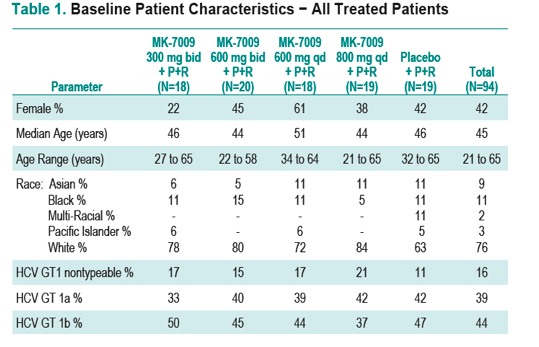
Efficacy (Table 2)
RVR rates in MK-7009-containing arms ranged from 69% to 82% vs. 6% of the control (per-protocol population).
MK-709 RVR rates were similar for the full analysis set population (range, 71 to 83%).
All of the MK-7009 dose groups were superior to control (p<0.0001), satisfying the primary efficacy hypothesis.
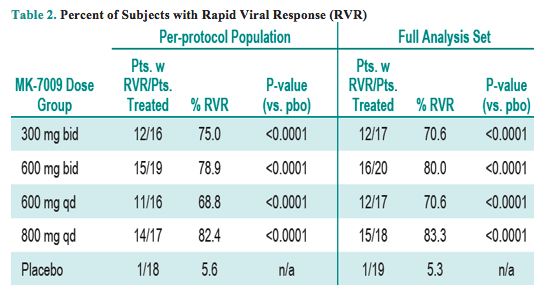
Efficacy
Percent of Subjects LLOD and LLOQ (Figure 3):
Greater than 80% of subjects treated with MK-7009 (all doses) had viral suppression to below LLOD on Day 28.
Viral suppression continued after MK-7009 was stopped, with 77 to 94% of subjects below LLOD on Day 42.
100% of subjects in the 600 mg bid MK-7009 dose group were below LLOQ from Day 21 through 42.
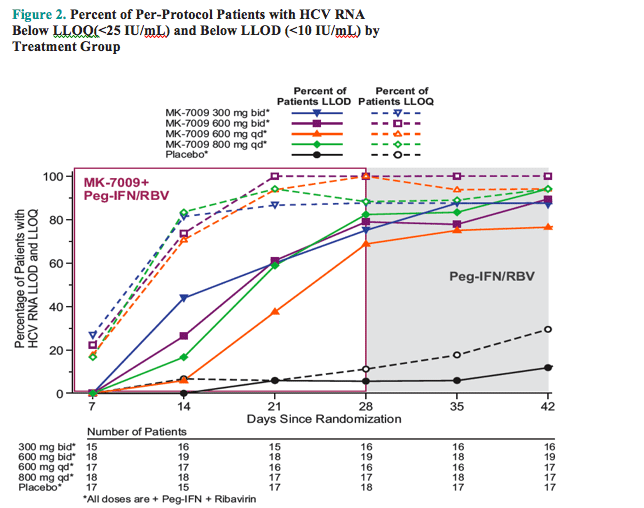
Efficacy
Protocol-defined Virologic Failures (Figure 3)
- Through day 42, patients in 600 mg qd and 600 mg bid groups who met criteria failure (Methods) did not have sufficient level of HCV RNA to perform resistance analysis (<1000 IU/mL). As a result, no resistance mutations were detected.
- Virologic failure was observed in 300 mg bid and 800 mg qd groups, with detection of HCV mutations known to confer resistance to MK-7009.
- Current studies are focused on understanding the evolution of resistance via longitudinal analysis of patient samples throughout the MK-7009 dosing period.
- In addition, amplicons will be subjected to clonal analysis to identify possible linkage between the observed mutants (i.e., R155K and D168V).
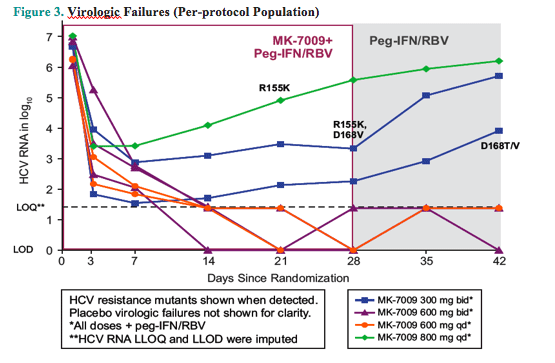
Safety
NNo serious adverse events and no discontinuations due to an adverse event were observed during the first 42 days.
TThe most common adverse events reported were headache, nausea, fatigue, and influenza-like illness, which were reported at similar rates across all treatment groups, including placebo (Table 3).
TThe incidence of nausea and vomiting appeared to be higher in the MK-7009 treatment groups compared to placebo (Table 3).
NNo increase in rash adverse events over placebo were observed.
No clinically significant changes in ECGs were observed.
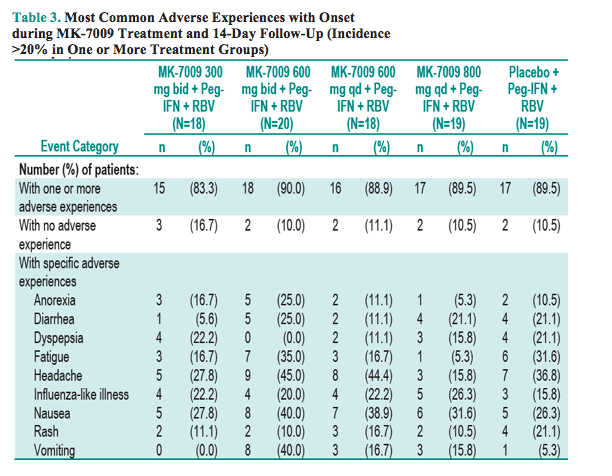
Summary of reported adverse experiences of vomiting (600 mg bid MK-7009)
DDay of onset: 1, 4, 5, 10, 16, 18, 20, 21.
DDuration: from 1d to 23d
44 out of 8 subjects had vomiting of 1 day or less in duration.
IIn 1 subject, vomiting routinely coincided with MK-7009 administration (Day 5 to --28)
VVomiting did not require anti-emetic treatment and did not lead to discontinuation, or dose reduction of MK-7009.
Laboratory trends over the treatment period showed:
DDecreasing and/or stable liver transaminase levels
Mean decreases in hemoglobin and absolute neutrophil count for MK-7009 groups similar to placebo
|
| |
|
 |
 |
|
|